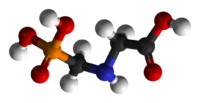
Photo from wikipedia
Abstract Double-crop grain sorghum after winter wheat harvest is a common cropping system in the southern plains region. Palmer amaranth is a troublesome weed in double-crop grain sorghum in Kansas.… Click to show full abstract
Abstract Double-crop grain sorghum after winter wheat harvest is a common cropping system in the southern plains region. Palmer amaranth is a troublesome weed in double-crop grain sorghum in Kansas. Populations resistant to various herbicides (e.g., atrazine, glyphosate, metsulfuron, pyrasulfotole) have made Palmer amaranth management even more difficult for producers. To evaluate control of atrazine-resistant and atrazine-susceptible Palmer amaranth in double-crop grain sorghum, we assessed 14 herbicide programs, of which 8 were PRE only and 6 were PRE followed by (fb) POST applications. Visible ratings of Palmer amaranth control were taken at 3 and 8 wk after planting (WAP) grain sorghum. PRE treatments containing very-long-chain fatty acid (VLCFA)–inhibiting herbicides provided 91% control of atrazine-resistant Palmer amaranth 3 WAP, and reduced weed density 8 WAP compared to atrazine-only PRE treatments. PRE fb POST treatments, especially those that included VLCFA-inhibiting herbicides, provided greater control (71% to 93%) of both atrazineresistant and atrazine-susceptible Palmer amaranth, respectively, at 8 WAP compared to PRE treatments alone (59% to 79%). These results demonstrated the utility of VLCFA-inhibiting herbicides applied PRE and in a layered PRE fb POST approach in controlling atrazineresistant Palmer amaranth, as well as the importance of an effective POST application following residual PRE herbicides for controlling both atrazine-resistant and atrazinesusceptible Palmer amaranth in double-crop grain sorghum. Nomenclature: Atrazine; glyphosate; metsulfuron; pyrasulfotole; Palmer amaranth, Amaranthus palmeri S. Wats.; grain sorghum, Sorghum bicolor L.; winter wheat, Triticum aestivum L.
Journal Title: Weed Technology
Year Published: 2019
Link to full text (if available)
Share on Social Media: Sign Up to like & get
recommendations!